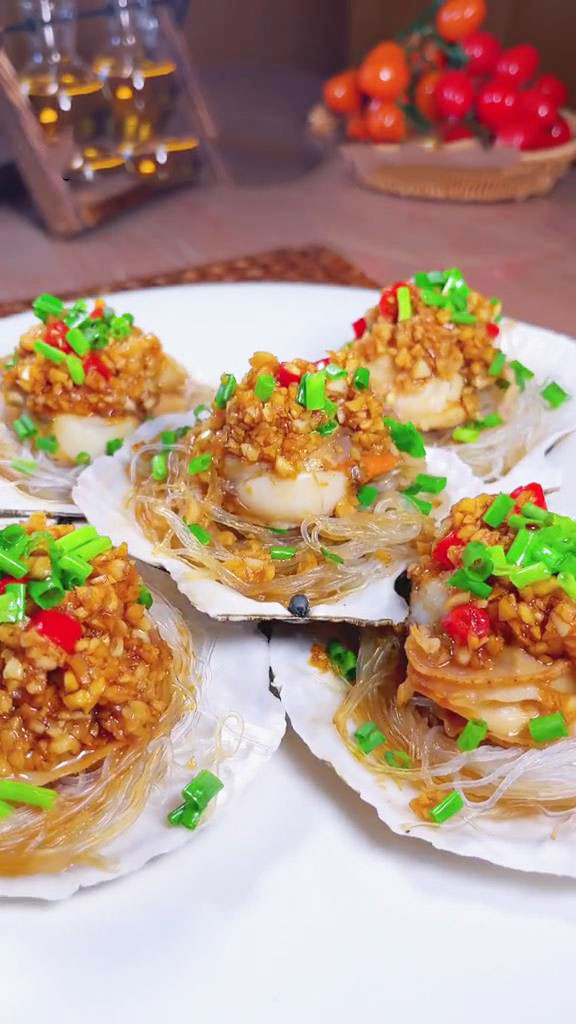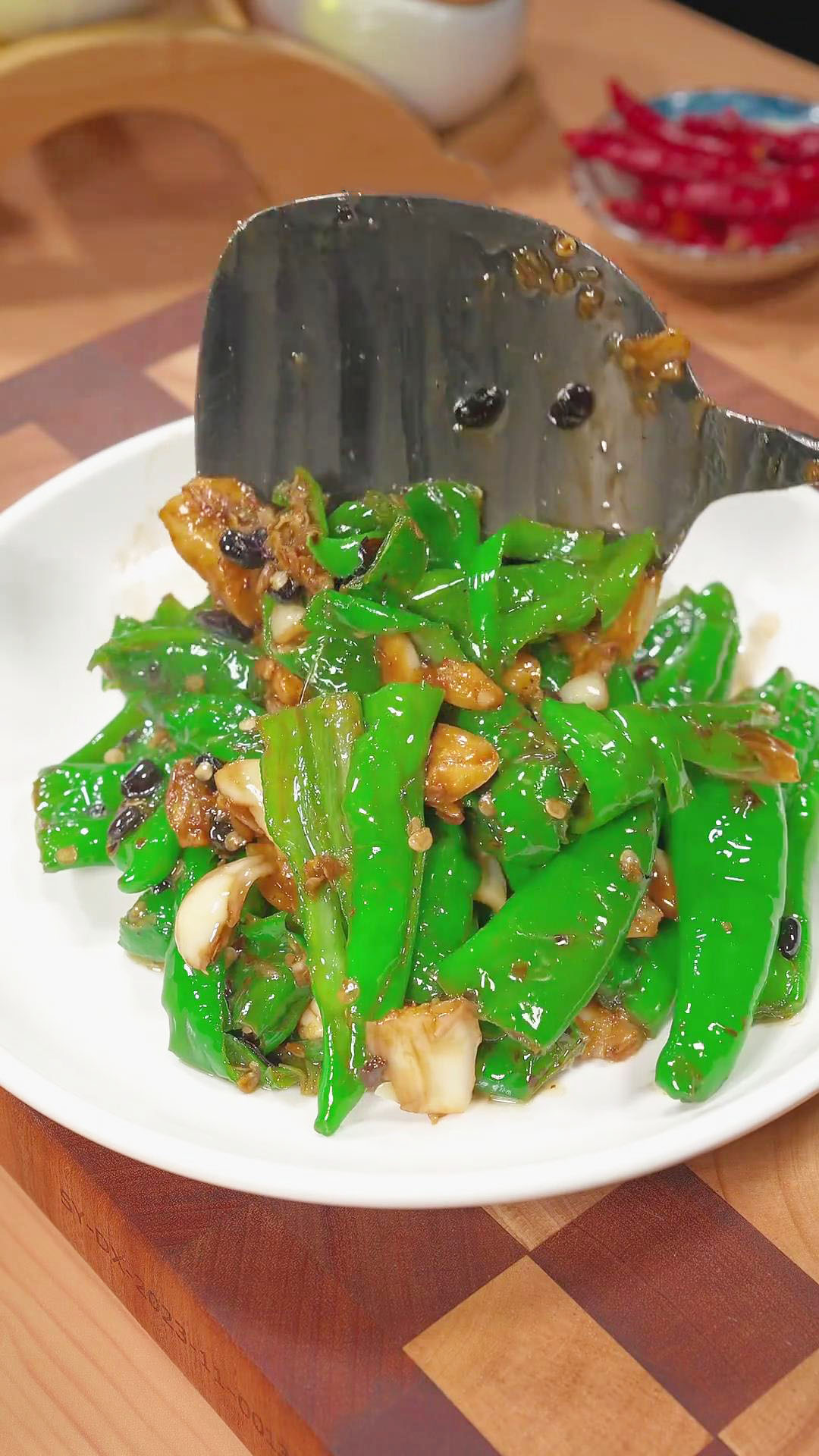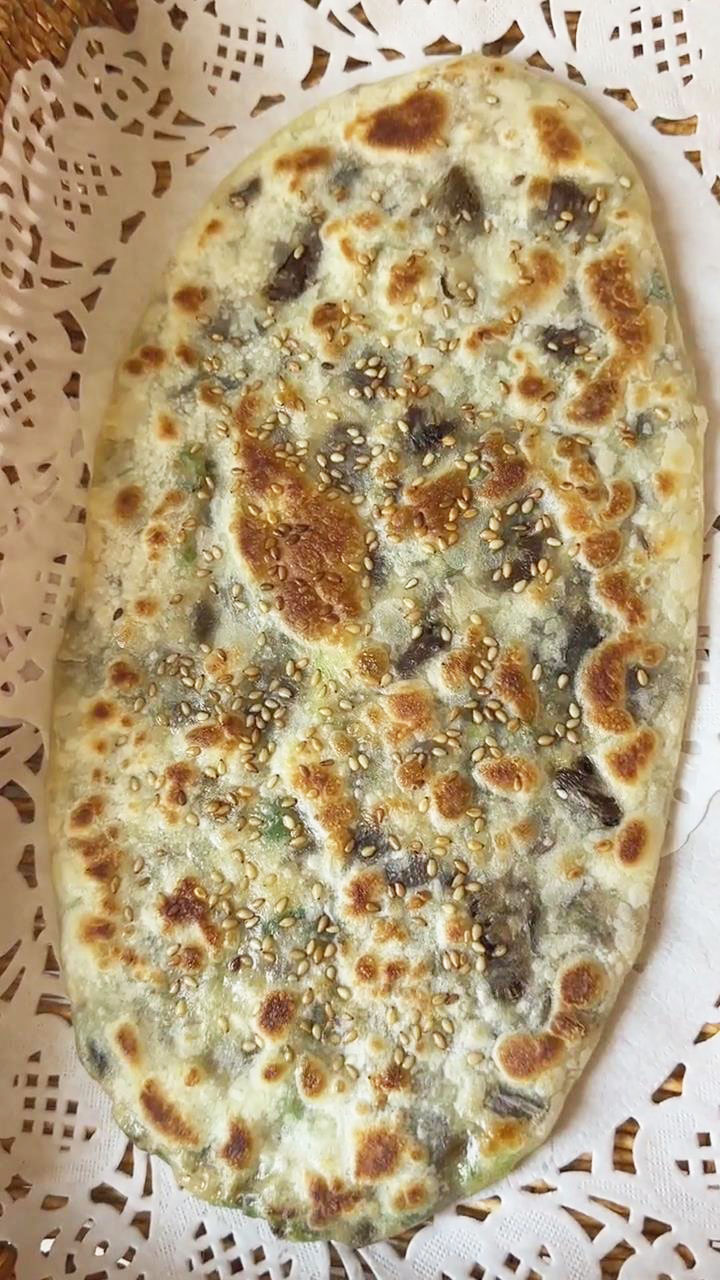This post may contain affiliate links. Please read our disclosure policy.
Elevate the way you make hard-boiled eggs by turning them into Chinese tea eggs. The eggs are deeply infused in a tea and soy sauce-based sauce. With this recipe, you can create the egg‘s same authentic marble look and have it as a snack or a light breakfast.
Chinese Tea Eggs: A Taste of Morning Nostalgia
Tea eggs, also known as cha ye dan, are a familiar sight in China, readily available from street vendors to local shops.
During my early days after graduating from college and entering the workforce, on busy mornings when time is tight for breakfast preparation, I often choose the convenience of grabbing two tea eggs, which I pair with a freshly steamed bun, such as Salted Egg Yolk Buns and Red Bean Paste Buns.
I complement this with a comforting bowl of Century Egg and Pork Congee. This routine was even better because I could always find these three items conveniently at a roadside eatery.
This simple yet satisfying breakfast combination always evokes a sense of nostalgia and comfort.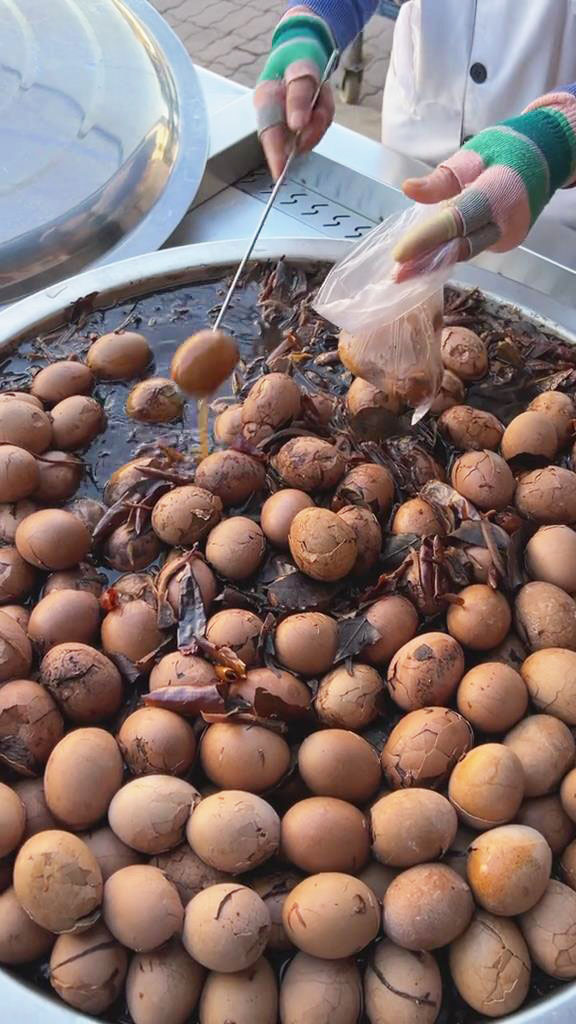
Roadside Tea Eggs
The traditional way of cooking tea eggs is quite a lengthy process since it involves cooking the eggs twice: Boiling the eggs to make hard-boiled eggs and simmering the eggs with the tea leaves, soy sauce, and several spices.
The traditional cooking method takes several hours to complete, and we all know we don’t have time for that.
Call it lazy, but my shortcut version of making tea eggs promises a delicious deep-flavored egg with a creamy center and beautiful marble look.
In this shortcut version, I boiled the eggs for 10 minutes before cracking them gently to let the sauce seep in and create that marble design later.
Unlike other recipes that require boiling the tea-based sauce separately, I combined all the sauce ingredients with the boiled eggs in one pot to simmer for 20 minutes.
Afterward, I let the eggs soak overnight with the sauce to fully infuse the flavors—and that’s it!
Love a good egg recipe? Here are other ways to cook eggs:
- Tofu And Eggs With Umami Sauce
- Sautéed Okra And Egg
- Silky Steamed Egg With Minced Pork
- Soy Marinated Egg (Korean Mayak Gyeran)
- Seaweed Egg Drop Soup
- Microwave Steamed Eggs
- Bitter Melon Stir-Fried With Eggs
Ingredient Alternatives And Suggestions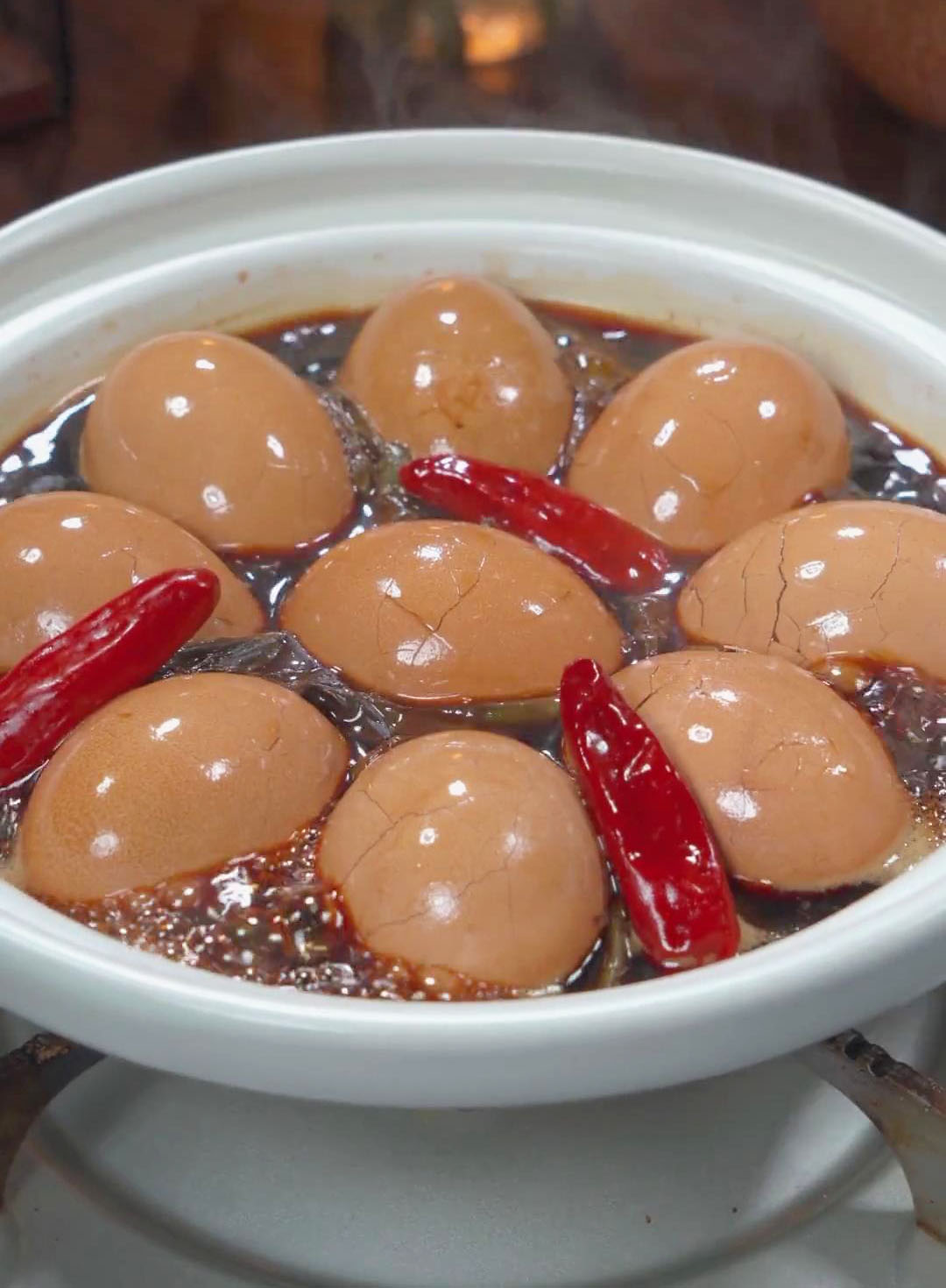
To get started, you will need eggs and the sauce ingredients. The sauce base requires your choice of tea leaves, light soy sauce, and dark soy sauce.
The taste of the sauce is then enhanced with these spices: green onions, ginger, star anise, cinnamon, bay leaves, dried chili peppers, salt, and sugar.
Now, the overall taste of your tea eggs will depend on the type of tea and spices you use. Nevertheless, you can expect the eggs to have an identical savory, umami, and intense tea taste and aroma.
Here are several ideas on how to customize your tea eggs with my ingredient alternatives and suggestions below:
- Eggs: Regular chicken eggs are typically used for Chinese tea eggs. You can use medium to large eggs and boil them for 10 minutes to make hard-boiled eggs.
- The recipe steps will change if you prefer soft or medium-boiled eggs. First, simmer the sauce for 10 minutes, then boil the eggs in a separate pot for 5 minutes (soft-boiled) or 7 minutes (medium-boiled). Then, let the eggs cool, gently crack them, and marinate them with the sauce overnight. The medium-boiled method resembles the process I use for making Soy Marinated Eggs.
- Quail eggs are also excellent alternatives to regular eggs, but you may need to adjust the boiling time and amount of seasonings.
- The secret to creating the beautiful marble look of the eggs is by properly cracking their shells and letting them steep in the sauce for a long time. I use the back of the spoon to gently crack the eggs. To create a more striking marble look, the eggs should be steeped overnight or up to 24 hours. However, keep in mind that the longer the steeping time, the saltier the eggs get.
- Tea leaves: Although you can use any type of tea, I recommend black tea leaves to contribute to making a more intense marble pattern since it has a darker color. However, you can still use tea that is available to you. I used about a tablespoon of dried black tea leaves. You can swap black tea leaves with 1 bag of black tea.
- Green onion: Green onions are great for their slight sweetness and mild onion taste. They can be replaced with other similar onions, such as chives or spring onions.
- Ginger: Ginger adds peppery and sweet flavors and a warming kick. You can swap fresh ginger with ground ginger. Add 1/4 to 1/2 tsp ground ginger for every 1 tbsp of fresh ginger.
- Star anise: Star anise is a star-shaped spice that lends a warm, woody, sweet, and licorice-like taste. Excellent substitutes for star anise are anise seeds, Chinese five spice powder, allspice, fennel seeds, and cloves. Read more about these alternatives with my guide: 5 Star Anise Substitutes.
- Cinnamon sticks: I incorporated two cinnamon sticks for a woody, spicy, and citrusy taste. You can swap cinnamon sticks for Chinese five spice powder, nutmeg, Allspice, or cloves.
- Bay leaves: Adding 3 bay leaves lends thyme and oregano flavors. Substitute this with dried oregano, thyme, or basil.
- Dried chili peppers: Dried chili peppers make it spicy and smoky. I used 7 pieces of red chili peppers, but you can adjust the amount according to your desired level of heat. If you are not a fan of spicy food, you can omit this from the sauce. If you don’t have chili peppers, you can substitute 1 whole chili pepper with 1/4 tsp chili flakes.
- Salt: Salt enhances the sauce by bringing out the flavors of the seasonings and helps the eggs absorb them more. Use any type of salt, such as sea salt, pink salt, and kosher salt, and adjust to taste.
- Sugar: Adjust the salty flavors with sugar, such as white sugar, cane sugar, brown sugar, maple syrup, or coconut sugar.
- Light soy sauce: Light soy sauce is the base of the sauce and gives it a deep umami and salty taste with notes of soybean. You can use regular soy sauce, tamari, liquid aminos, coconut aminos, or gluten-free soy sauce.
- Dark soy sauce: It is actually dark soy sauce that deepens the color of the eggs, not light soy sauce. Dark soy sauce is a crucial ingredient in intensifying the marble pattern of the eggs, so make sure not to omit this.
- Optional seasonings: Add Shaoxing wine if you prefer a slightly sweet and briny taste. If you prefer a numbing effect and an earthy, citrusy taste, add a teaspoon of Sichuan peppercorns.
Ingredients And Kitchenware
I used a clay pot for this recipe because it tends to retain and distribute heat evenly throughout the pot. This way, it cooks the eggs gently and steadily during simmering. If you don’t have a clay pot, you can use a regular pot for boiling.
To crack the eggs, using just the back of a spoon will work. Lastly, it helps to have a kitchen timer to keep watch on the time and avoid overcooking the eggs. Here are the ingredients to prepare and adjust the amount according to your preference:
- 9 eggs
- 1 tbsp of black tea leaves (or 1 black tea bag)
- 5 chopped green onions (2 inches long)
- 5 slices of ginger
- 2 pieces of star anise
- 2 cinnamon sticks
- 3 bay leaves
- 7 dried chili peppers
- Water (to fill the pot)
- 1 tbsp of salt
- 1 tbsp of sugar
- 3 tbsp of light soy sauce
- 3 tbsp of dark soy sauce
4 Easy Steps To Make Chinese Tea Egg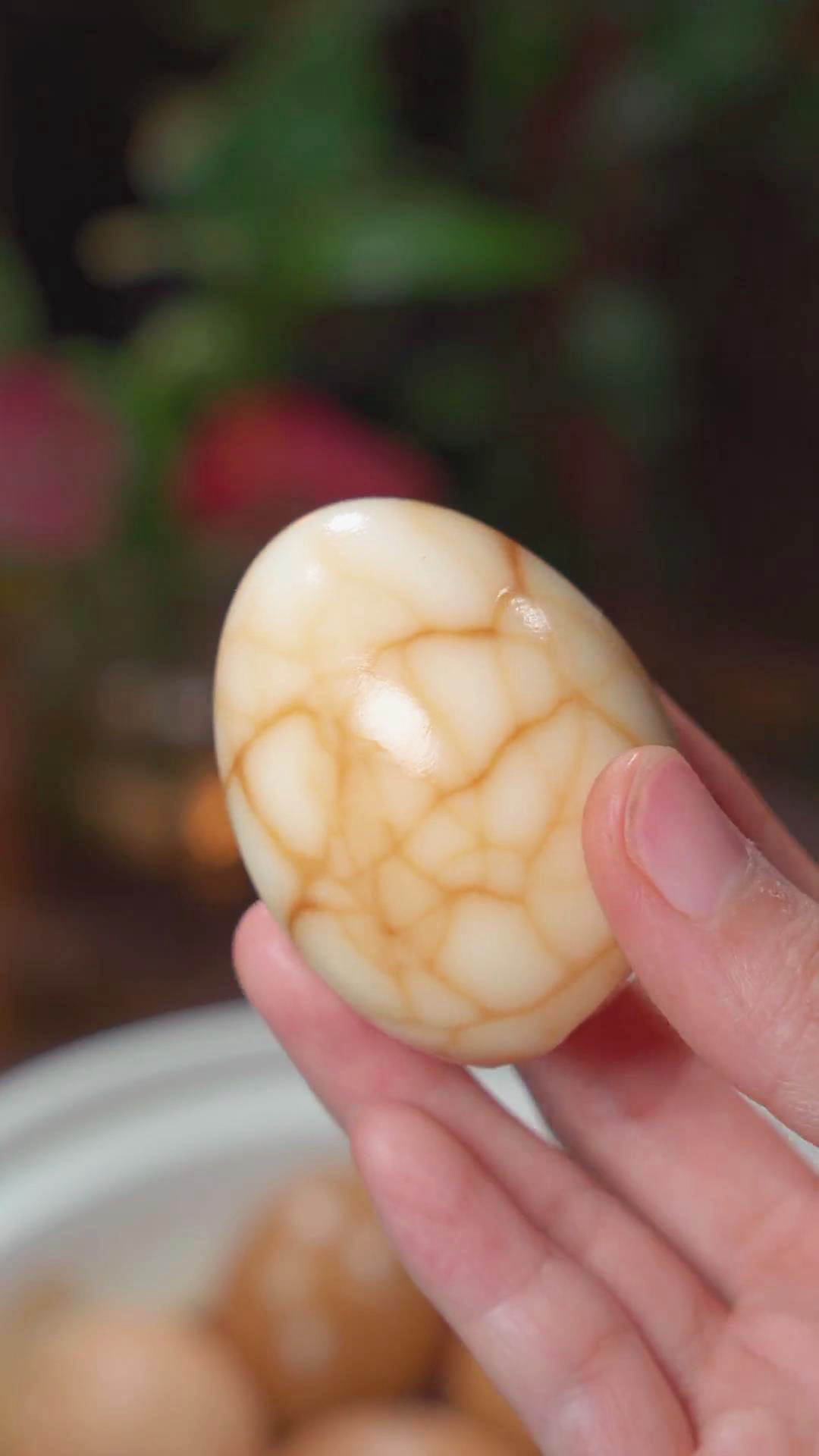
The 4 main steps to remember are: prepare the eggs, combine the eggs and sauce, simmer, and soak. Follow these steps with my detailed instructions below. I recommend watching my short tutorial video on Instagram or TikTok to learn more.
Enjoy Chinese tea eggs as a side dish, with a bowl of rice, soup, noodles, congee, or sandwich. If you have tips and recommendations for this recipe, share them in the comments section. Don’t forget to tag me @kitchenmisadventures to show your version of Chinese tea eggs.
1. Boil and crack the eggs.
- If the eggs came from the fridge, let the chilled eggs come to room temperature. It is essential to bring the eggs to room temperature to prevent the shells from cracking during the boiling step.
- Place the eggs in a pot and fill it with cold water. Make sure the eggs are fully submerged in water.
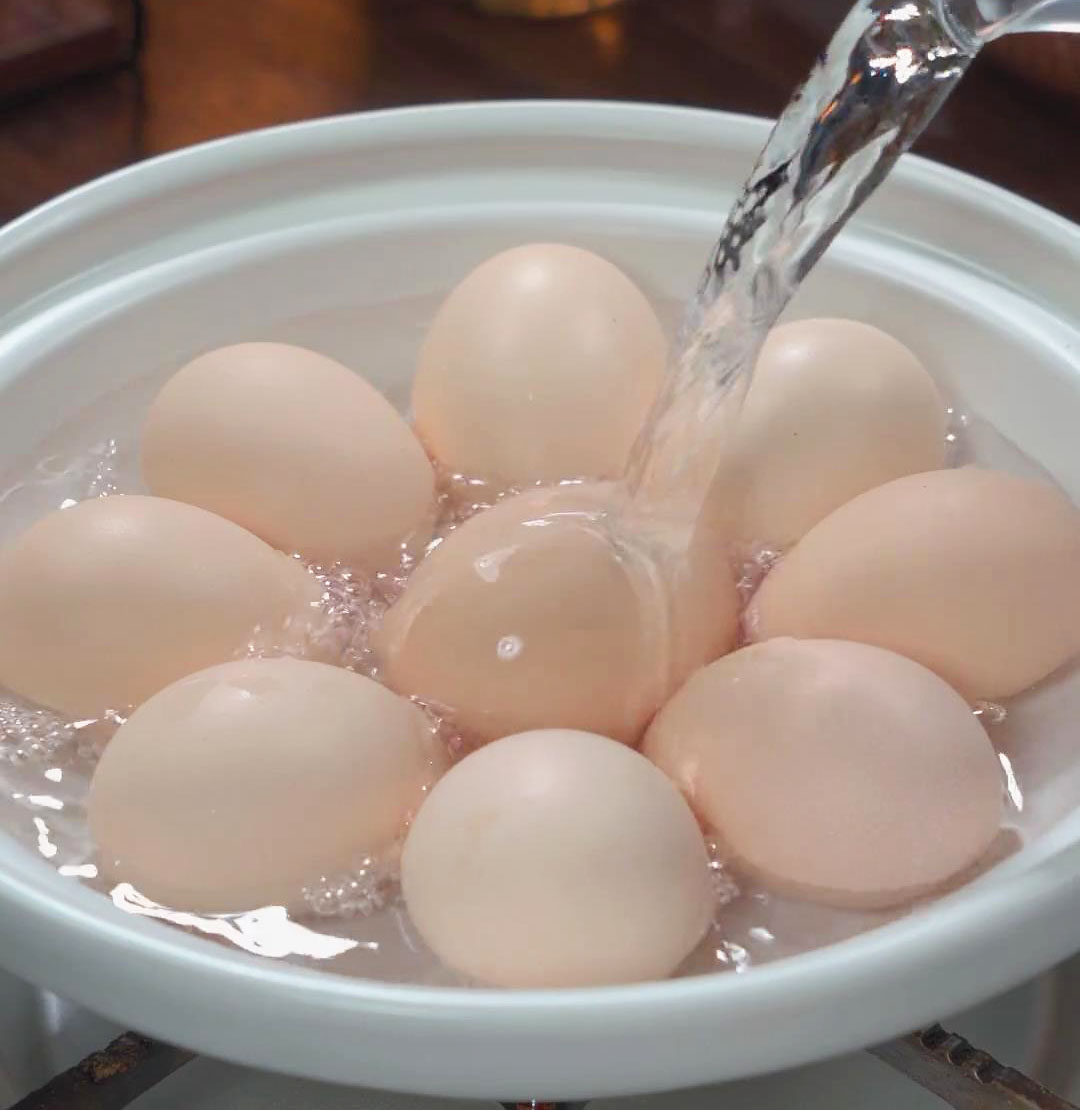
- Bring the pot to a boil and let the eggs cook for 10 minutes over medium-low heat, ensuring it maintains a gentle boil throughout.
- When done, carefully drain the water.
- Then, gently crack the eggshells using the back of the spoon. Making the cracks is essential to let the eggs fully absorb the sauce and create the marble pattern.
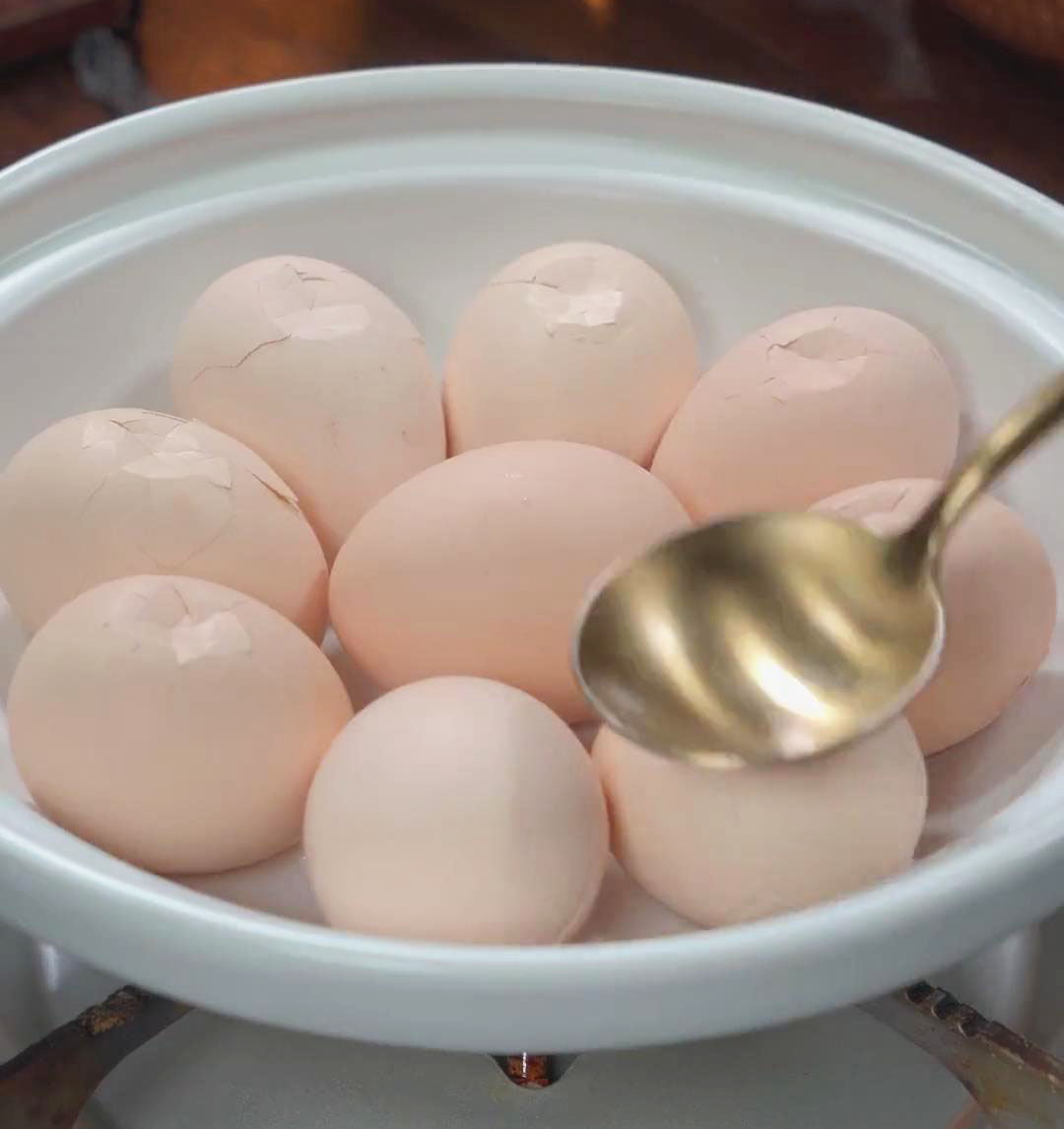
2. Combine the eggs with the sauce.
- With the eggs in the pot, add tea leaves, green onions, ginger, star anise, cinnamon, bay leaves, and dried chili peppers.
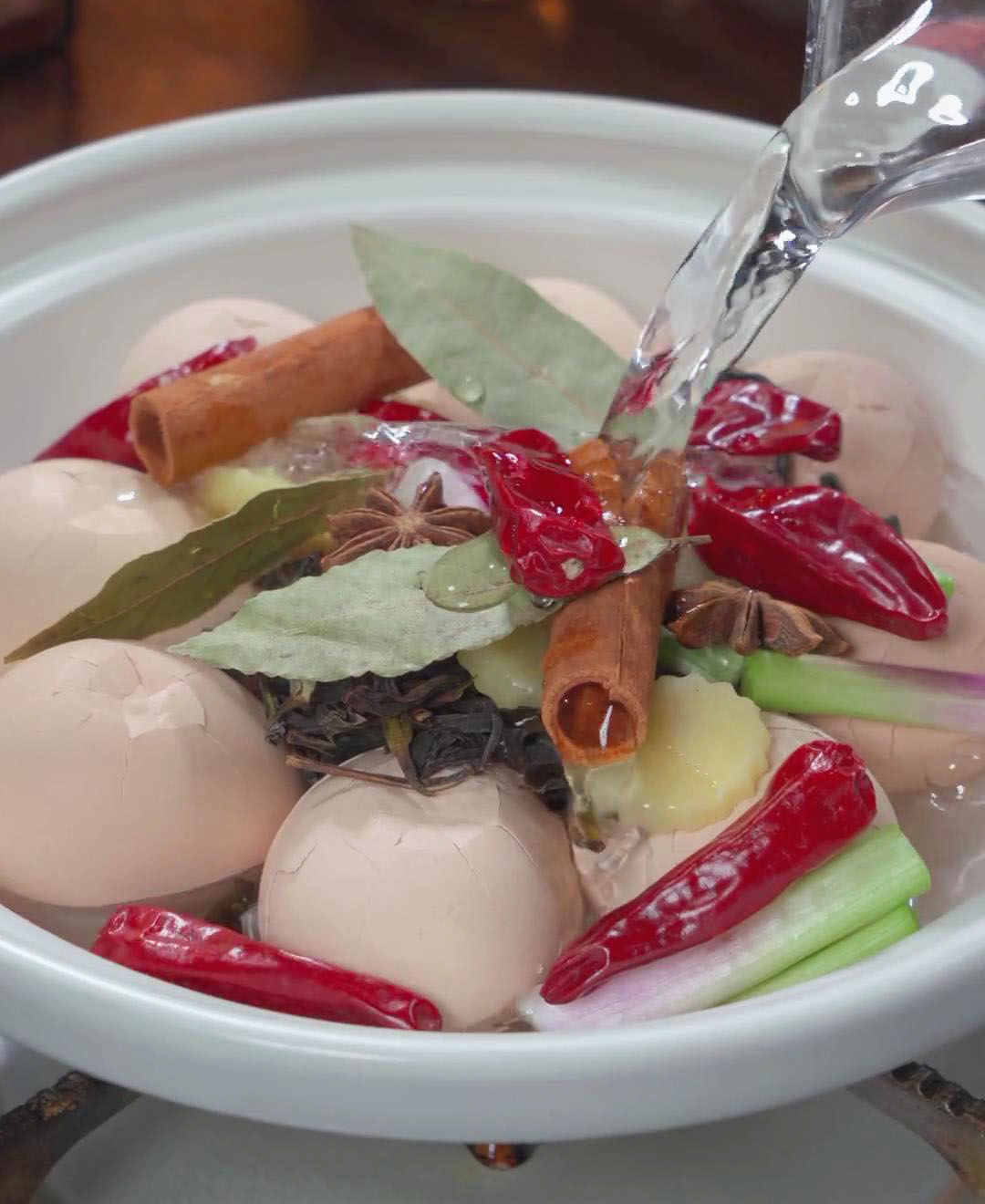
- Fill the pot with water and add salt, sugar, light soy sauce, and dark soy sauce. The water should be enough to submerge the eggs.
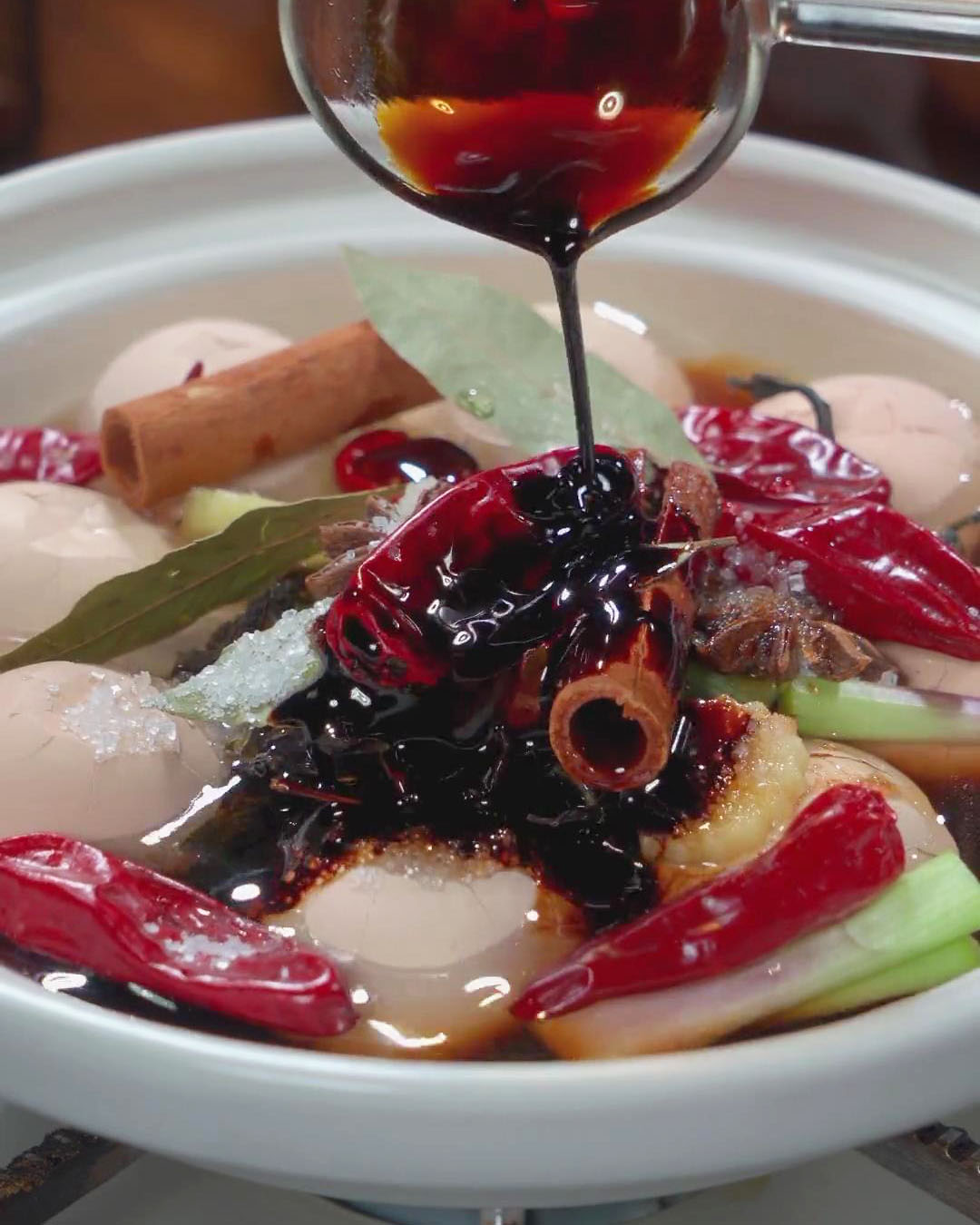
3. Simmer the eggs and sauce.
- Simmer over low heat for 20 minutes with the lid on.
- After 20 minutes, turn off the heat.
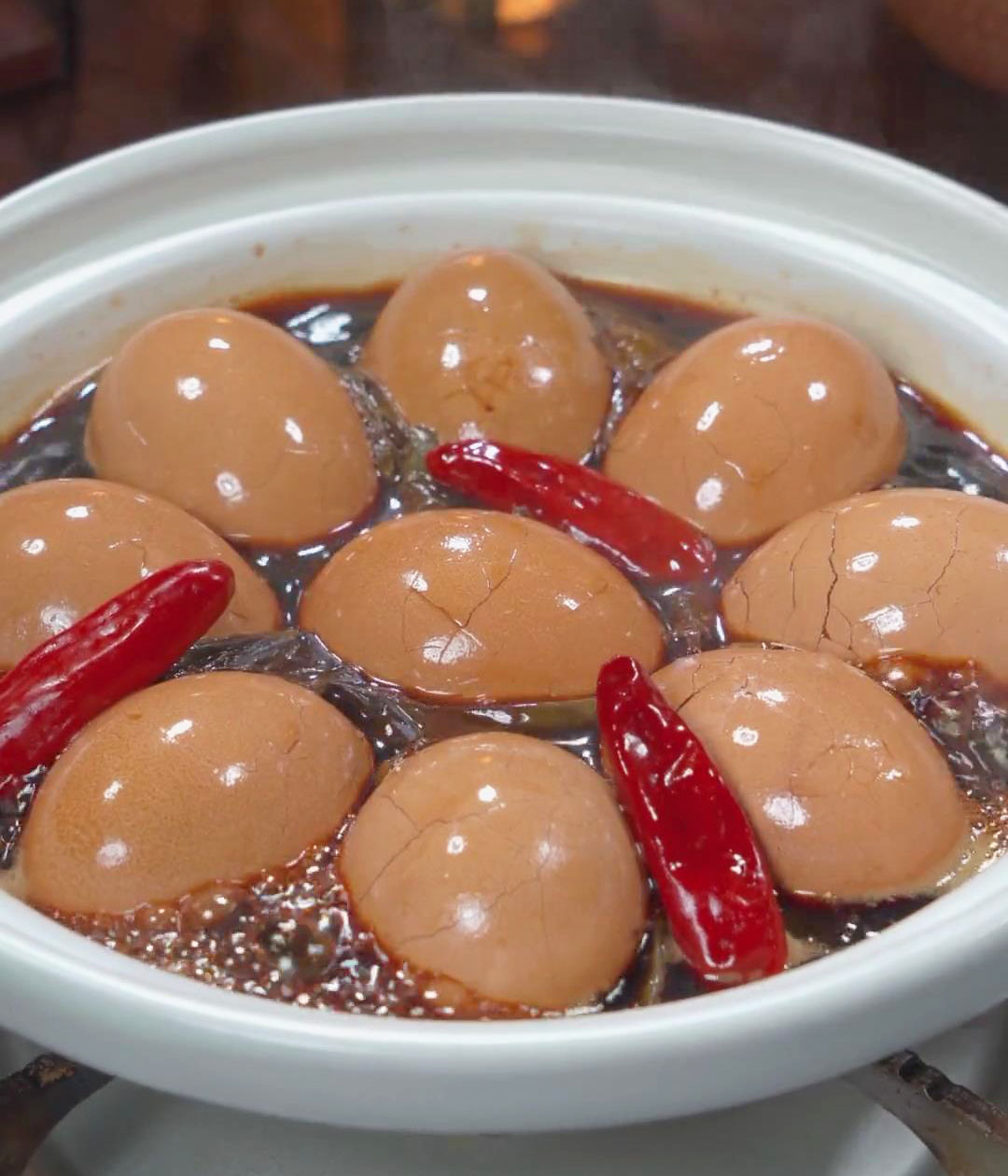
4. Soak the eggs in the sauce.
- Let it soak overnight for full flavor absorption and a more intense marble pattern. You can soak it in the refrigerator overnight or for up to 24 hours. Do not soak for more than 24 hours; otherwise, the eggs will become too salty.
- If the eggs are not fully covered with sauce, flip them halfway through the steeping time to submerge the other side of the egg.
- When done steeping, remove the eggs from the sauce and store it in the fridge for up to 4 days. If you have leftover sauce from steeping, you can reuse it for another batch of tea eggs. Store the leftover sauce in an airtight container and reuse it by boiling it again and adjusting the taste with additional seasonings. You may need to adjust the taste since the saltiness and flavors have lessened after cooking the first batch of tea eggs.
***Tip: Steps 1 to 4 will change if you prefer soft or medium-boiled eggs. First, boil the eggs for 5 minutes (soft) or 7 minutes (medium-boiled), let them cool in an ice bath to stop cooking further, and crack the eggs. Then, simmer the sauce for 10 minutes in a separate pot. Combine the simmered sauce with the boiled eggs and soak overnight.
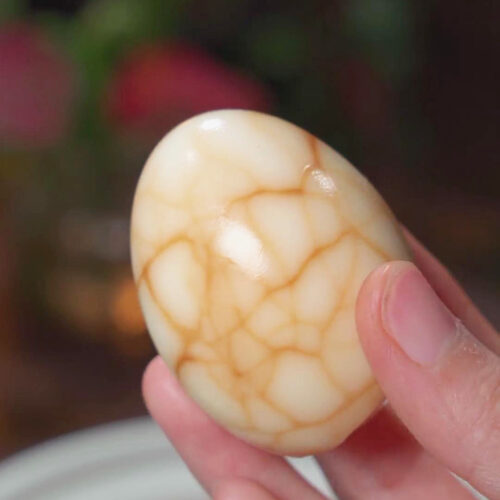
How To Make Tea Egg
Ingredients
- 9 eggs
- 1 tbsp black tea leaves or 1 black tea bag
- 5 chopped green onions 2 inches long
- 5 slices ginger
- 2 pieces star anise
- 2 cinnamon sticks
- 3 bay leaves
- 7 dried chili peppers
- Water to fill the pot
- 1 tbsp salt
- 1 tbsp sugar
- 3 tbsp light soy sauce
- 3 tbsp dark soy sauce
Instructions
Boil and crack the eggs.
- If the eggs came from the fridge, let the chilled eggs come to room temperature.It is essential to bring the eggs to room temperature to prevent the shells from cracking during the boiling step.
- Place the eggs in a pot and fill it with cold water. Make sure the eggs are fully submerged in water.
- Bring the pot to a boil and let the eggs cook for 10 minutes over medium-low heat, ensuring it maintains a gentle boil throughout.
- When done, carefully drain the water.
- Then, gently crack the eggshells using the back of the spoon. Making the cracks is essential to let the eggs fully absorb the sauce and create the marble pattern.
Combine the eggs with the sauce.
- With the eggs in the pot, add tea leaves, green onions, ginger, star anise, cinnamon, bay leaves, and dried chili peppers.
- Fill the pot with water and add salt, sugar, light soy sauce, and dark soy sauce. The water should be enough to submerge the eggs.
Simmer the eggs and sauce.
- Simmer over low heat for 20 minutes with the lid on.
- After 20 minutes, turn off the heat.
Soak the eggs in the sauce.
- Let it soak overnight for full flavor absorption and a more intense marble pattern. You can soak it in the refrigerator overnight or for up to 24 hours. Do not soak for more than 24 hours; otherwise, the eggs will become too salty.
- If the eggs are not fully covered with sauce, flip them halfway through the steeping time to submerge the other side of the egg.
- When done steeping, remove the eggs from the sauce and store it in the fridge for up to 4 days. If you have leftover sauce from steeping, you can reuse it for another batch of tea eggs. Store the leftover sauce in an airtight container and reuse it by boiling it again and adjusting the taste with additional seasonings. You may need to adjust the taste since the saltiness and flavors have lessened after cooking the first batch of tea eggs.
Video
Nutrition

